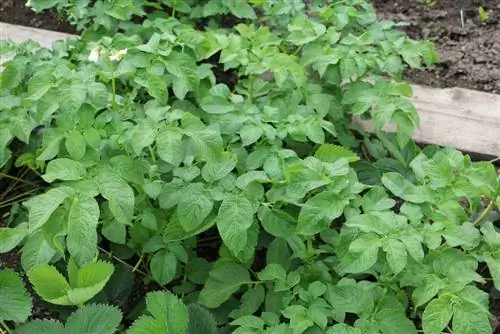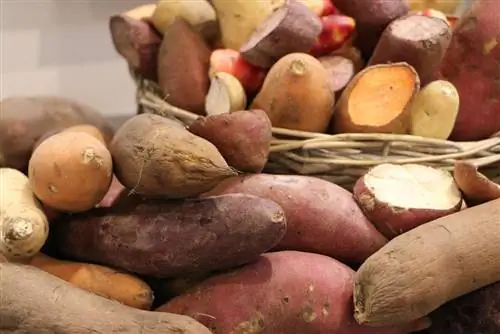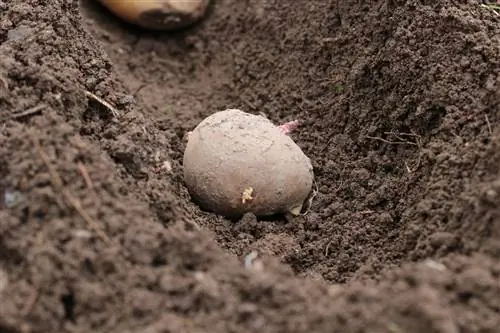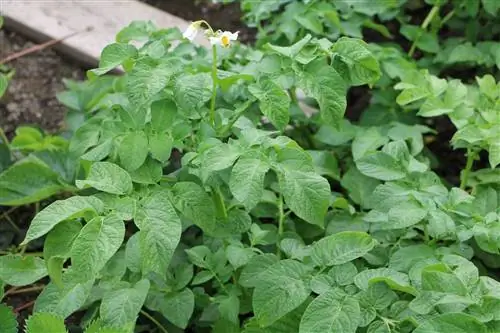- Author admin [email protected].
- Public 2023-12-17 03:39.
- Last modified 2025-01-24 12:45.
The blue potato has become extremely rare in home gardens. It differs from lighter varieties primarily in its appearance, which is a real delight for people who eat with their eyes. But the blue potato also offers a special variety in the kitchen in terms of taste, because it tastes slightly nutty, comparable to a sweet chestnut. The waxy type of potato can be used in many popular dishes.
Sowing and site conditions
Award-winning chefs like to use the blue potato as a delicacy. If you buy them at the market, they are quite expensive because they are harvested by hand. Growing your own potatoes is very easy and differs little from other types of potatoes. The blue potatoes include around a hundred different varieties, such as the “Blue Swede”, the “Vitelotte”, the “Linzer Blaue” or the “Truffle potato”. In order to grow blue potatoes in your own garden, the arable land should be prepared in autumn. A shady place in the garden must not be chosen as the plant needs a lot of light. In preparation, the bed is dug deep. However, this should only happen in frost-free weather; a minimum earth temperature of around eight degrees Celsius is the ideal condition for this, which is usually the case in mid-April. Before planting, the clods of earth are broken up with a cultivator; a tiller makes this work easier. Leveling the earth's surface is ideal with a rake. If you stretch a string to mark the rows in which the potatoes are to be planted, it is much easier to create a straight bed. Holes about 15 centimeters deep are then dug with a spade. It is important to ensure that the plants are spaced about 40 centimeters apart so that the potatoes have enough space; a distance of 60 centimeters must be maintained between the individual rows. Now the actual planting of the blue potato begins. These are simply placed in the previously dug hole in the ground and covered with soil.
Care, fertilization, watering and harvesting
It is very important for the development of the plant that it is regularly removed from weeds. Sufficient light on long days ensures that lots of green weeds grow. Potato plants obtain their nutrients through light production and photosynthesis. These nutrients are then delivered to the fruit that grows in the soil. If the first shoots become visible on the surface of the earth, the earth should be loosened and piled up regularly. This piling up of soil is important so that the tubers do not come to light, otherwise they will turn green and develop the toxin solanine. If this is the case, the potato can no longer be eaten. On very dry days the plant needs to be watered so that the yield can increase. Potatoes have very high nutritional requirements. In reserve, you can fertilize generously with compost in the fall. The blue potatoes also particularly like stone flour. Depending on the variety selected, the harvest takes place from mid-summer through to autumn. You can tell whether the fruits are ripe by the browning of the leaves above the ground. Harvesting your own potatoes is a real treasure hunt because you first pull the plant out of the ground. Many potatoes will hang from the root ball and can be harvested by hand. To ensure that no yield is lost, it is worth digging up the area of soil a little more and collecting the potatoes there. For each potato planted, you get up to 60 tubers back as a harvest yield. The blue potatoes have a purple-blue to black skin. The flesh can also have different shades of blue.
Diseases and pests
As the name suggests, Colorado potato beetles are particularly fond of the tuber. If these beetles are discovered, they should be collected. Dusting the plant with algal lime keeps the animals away from the plant. Snails can also be a pest. You can work with biological snail poison here. You can also do it without poison by placing straw or prickly and dry blackberry branches around the plants. The snails cannot crawl over the branches. Late blight, also known as potato powdery mildew, is the most common disease. It is caused by a fungus and causes plant rot, which can be seen by the discoloration of the leaves.
Propagation and Storage and Use
It is best to save some seed potatoes from the potato harvest for next year. These should have several eyes. To store them optimally for the next gardening season, place them in a flat box with their eyes still on top. If they are stored at around 15 degrees Celsius and in a bright place, they usually sprout very quickly and can then be replanted in this condition. To store the harvest for the winter, it's best to find a cool, dark room, such as a basement or garage. They can be stored loosely in wooden boxes, but it is important that they are covered with newspaper so that they do not turn green or sprout. The blue potatoes feel most comfortable at a storage temperature of around four degrees Celsius and a humidity of around 55 percent. Thanks to the color pigment anthocyanin, which is responsible for the color of blue potatoes, this type of potato is a particularly popular way to minimize the risk of cancer. Anthocyanin is also said to have a positive influence on vision and body tissue. Above all, the blue potato is a tasty speci alty among potatoes and can be processed into many popular dishes.
What you need to know about the blue potato
Certainly not many modern gardeners have had blue potatoes in their garden or on their table.

But that is solely because the earth fruit in the blue version went out of fashion over the years in the 19th century, as other, brighter and more durable varieties came onto the market and into the fields. When it comes to cultivation, the blue potato is no different from other types of potatoes. In the spring, like its other-colored colleagues, it is planted in the ground that has been formed into furrows. At harvest time, the tubers can then be harvested by hand in the garden and in the field. As the name suggests, the potatoes have a blue, purple or almost black skin and, when raw, a flesh that is marbled in various shades of blue or purple.
Origin and current status of the blue potato
The similarity to normal, light-colored potatoes is very great with a blue variety - except for the different coloring. It was brought to Europe from central and southern America after 1500 and the plant has been native here ever since. However, blue potatoes can only be found in a few gardens today, as their popularity has declined significantly.
In the star kitchen, the top chefs add color to their plates, but otherwise the blue potato is only available in very special delicatessen shops - mostly imported from Peru or Bolivia.
The light-colored potato varieties have established themselves in the kitchen, but also because they are easier to grow and have therefore become increasingly popular. The blue potato disappeared from the menu. Nevertheless, there are around a hundred varieties, including those known as Blue Swede, Truffle Potato, Vitelotte or Linzer Blaue.
Using the blue potato
The blue potato offers one thing above all, not just in terms of color but also in taste: variety in the kitchen. It tastes earthy, slightly nutty and has a similar taste to chestnuts.
The waxy potatoes can be used to make any potato dish, but because they are harvested by hand they cost a lot more than normal, light potatoes. The blue potato is said to have an anticancer effect in humans thanks to its ingredient anthocyanin.






